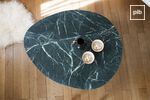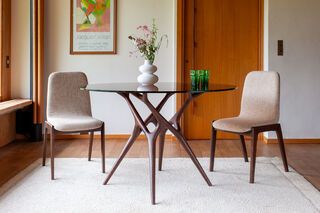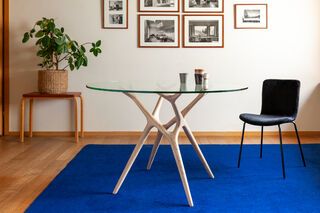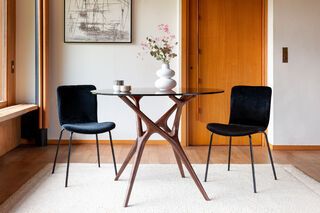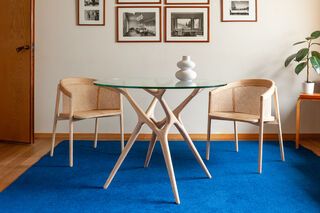Organic dining tables
Organic dining tables break away from rigid geometries to introduce free, continuous forms into space. An organic table is set in a moving volume, without strict axes or defined angles. The tabletop follows a curved, often asymmetrical line, guiding circulation around the piece without constraining it. This typology is well suited to open compositions, where the points of use are distributed without hierarchy. The base can follow the shape or contrast with it. These tables introduce a strong formal variation while ensuring the same stability as a more conventional model.
read more >Filters
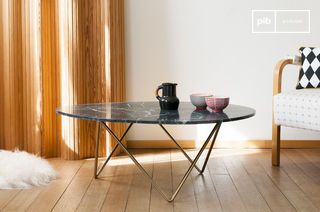
Green marble coffee tableTrivisan
€595 €535-10%

Round metal coffee table OneXylème
€495 €445-10%
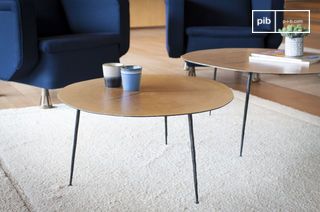
"Round metal coffee table ""Two"""Xylème
€495 €445-10%
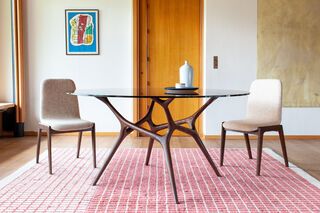
Round glass table with dark solid ash for 8 peopleSylvae
€1280 €1150-10%
10 festive days
10% off our tables and consoles
Welcome your guests in style · Limited stock
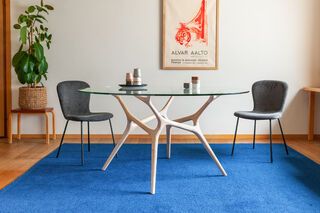
Round glass table with light solid ash for 8 peopleSylvae
€1280 €1150-10%

Understanding the principles of an organic table
An organic table is based on irregular, continuous lines inspired by natural forms. Unlike rectangular, round or square tables, it is not bound by strict symmetry or fixed geometric proportions. The shape of the tabletop varies according to a free line, with no sharp angles, which alters the perception of center and contours. This absence of rigid geometry allows for more flexible insertion into open, asymmetrical or evolving configurations.
Organic dining tables find their place in spaces where circulation is fluid, and where the layout does not follow a frontal logic. They enable a non-hierarchical distribution of seating and adapt to flexible uses: informal meals, small-group discussions, working with others. Their layout allows them to naturally bypass other furniture or walls, without the need to recenter or align. This function is based on a continuity of design rather than a formal anchoring.
Formats, dimensions and placement in space
An organic table can measure from 160 to over 220 cm in length, depending on the curve of the top. Width varies locally, creating wider or narrower zones depending on possible uses. It's not a question of losing usable surface area, but of redistributing contact zones differently: some areas more easily accommodate central objects, others are more accessible from the seats.
This type of table requires a careful reading of the environment. It must benefit from clearance equivalent to that of a rectangular table, but the logic is not axial: flows adapt to the curves of the tabletop. This ensures smooth, uninterrupted circulation, with no corners to negotiate. It can be positioned freely in the room or slightly oriented to follow a natural line of passage.
The base varies according to model. Some follow the shape of the tabletop, incorporating several discreet support points. Others deliberately contrast with the curve of the tabletop to create visual tension or emphasize mass. The base can also contribute to balance, visually refocusing the structure if the shape of the top is highly asymmetrical. Stability remains equivalent to that of a classic model, provided it is well anchored to the floor.
Materials, finishes and visual perception
The material of the top plays a major role in the visual reading of an organic table. Solid or veneered wood is often preferred, for its ability to absorb curves while retaining a legible texture. Certain species, such as oak, walnut or ash, work well with non-rectilinear lines without creating visual discontinuities. Wood also allows for variable thickness, with beveled or smoothed edges that reinforce the softness of the shapes.
Stone, ceramic or mineral composites are sometimes used, notably with water-jet cuttings or specific molds. These materials offer a hard, stable surface, but require particular attention to edges and joints. Finishes are generally matte or satin, to avoid stray reflections on complex curves. Glass is more rarely used, as its transparency complicates the reading of an already irregular shape.
The contrast between the curve of the top and the rest of the furnishings must be measured. An organic table can soften a very orthogonal interior or extend an environment already composed of free-form shapes. It can also introduce a gentle break in a neutral space, without imposing a strong color or material. Its role is often to link elements without imposing itself as a single focal point.
Choosing an organic table means assuming a non-linear form in the dining space. It allows a variation in visual rhythm, flexible adaptation to usage, and a re-reading of centrality in layout. It is designed for open configurations and evolving uses, without excluding stability or comfort.
